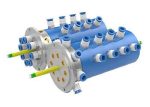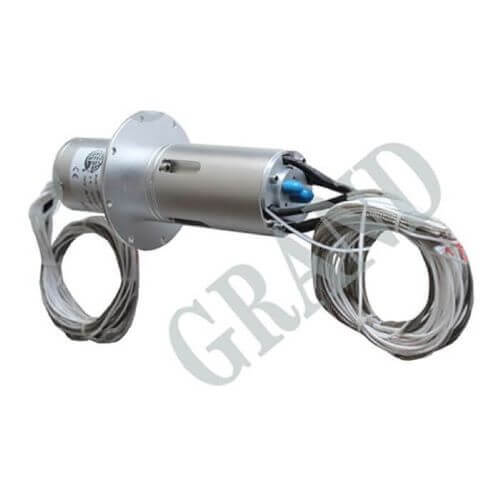A slip ring is an electromechanical device that allows the transmission of power and electrical signals from a stationary to a rotating structure. It can be used in any electromechanical system requiring unrestrained, intermittent, or continuous rotation while transmitting power and data. The slip ring, also known as an electrical rotary joint, rotary electrical interface, or collector, plays a pivotal role in diverse fields, including industrial machinery, wind turbines, radar systems, video systems, and medical equipment.
The importance of slip rings spans across a multitude of industries. In the aerospace industry, slip rings help maintain connectivity in systems while still allowing for constant 360-degree rotation. In the renewable energy sector, specifically wind turbines, they enable the transfer of electricity from the constantly moving turbine blades to the stationary tower. In the realm of medical devices, particularly in CT scanners, slip rings provide a continuous electrical connection between the stationary computer system and the rotating gantry that spins around the patient.
The concept of the Harmonized System of Nomenclature (HSN) code is significantly intertwined with slip rings, especially in the sectors of manufacturing and commerce. An HSN code, including the slip ring HSN code, is an internally standardized naming and numbering system adopted to classify traded products. Established and managed by the World Customs Organization (WCO) in 1988, the understanding of the HSN code is vital for manufacturers, traders, and buyers. It aids in itemizing goods on invoices, determining tax rates under the Goods and Services Tax (GST) regime, and sustaining a globally recognized classification system. Consequently, this greatly enhances the ease, efficiency, and compliance of commerce and trade with international trade and customs laws.
Slip Ring HSN Code
The HSN code for slip rings varies depending on their application, design, and materials used. A specific HSN code is assigned to each category of slip rings to maintain accurate classification. For instance, the HSN code for slip rings meant for use in electrical motors and generators typically falls under 8503.00.10. It is crucial to identify the correct HSN code to ensure compliance with international trade and taxation regulations.
Several factors determine the HSN code classification for slip rings. These factors include the purpose or application (industrial, commercial, or residential), construction material (such as copper, brass, or any specific alloys), the type of slip ring (pancake, mercury-wetted, or capsule), the current and voltage ratings they are designed to handle, and any additional specifications or design features. By accounting for these factors, businesses can accurately classify their products and streamline documentation and customs clearance processes.
When comparing slip rings with similar HSN codes, one may notice that a particular HSN code may cover a range of slip rings differing in design, materials, or application. Comparing various slip rings under the same code helps to pinpoint nuances within that category and gauge whether a specific product falls under the same classification. This understanding aids in making well-informed decisions regarding trade, compliance, taxation, and product development.
In conclusion, accurately identifying the specific HSN code for slip rings is vital for manufacturers, exporters, and importers, ensuring that they adhere to local and international trade regulations and taxation guidelines. It fosters coherence and facilitates global trade interactions, providing clear and streamlined paths toward the success of businesses operating within this segment.

Slip Ring HSN Code: User Concerns
Tax Implications and GST Rates for Slip Ring HSN Code
Understanding the tax implications associated with a slip ring HSN code is critical for businesses to ensure proper compliance with tax regulations. The HSN code directly impacts the determination of the Goods and Services Tax (GST) rate that applies to the product. This tax rate varies depending on the type, specifications, and applications of the slip ring in question. Accurate knowledge of the appropriate HSN code and the corresponding tax rate helps businesses calculate and report their tax liabilities and enables consumers to understand the tax component in the purchase price.
Proper Classification and Documentation for Trade Compliance
Ensuring proper classification and documentation for slip rings is essential for trade compliance, both domestically and internationally. Accurate HSN code classification is vital to avoid complications during customs procedures, import or export processes, and trade negotiations. Failing to classify or document products correctly may lead to legal issues, financial penalties, or delays in clearance. Therefore, businesses must allocate resources to understand their products’ nature and use the correct HSN code in all trade-related documentation. This vigilance eventually results in reduced risk exposure, a well-organized trade process, and a healthier business environment.
Updates and Revisions in HSN Code for Slip Rings
It is crucial for businesses dealing with slip rings to stay updated on any revisions or amendments in HSN codes. The World Customs Organization (WCO) periodically reviews and revises the Harmonized System to reflect changes in technology, market trends, or international trade standards. By staying current with these updates, businesses can maintain compliance with any new developments and adapt quickly to shifts in trade policies or taxation structures. Moreover, revisions in HSN codes can directly impact the business’s bottom line, as changes may result in altered tax rates or adjustments in import or export incentives.
In conclusion, addressing the key concerns related to HSN codes for slip rings – tax implications, proper classification, documentation, and staying updated with revisions – is paramount for businesses to maintain compliance, transparency, and growth in a complex and ever-evolving world of trade and taxes. Each of these aspects contributes significantly to the success of businesses operating within this segment and helps them navigate the intricacies of international trade with ease.
Slip Ring Manufacturing and HSN Code
Importance of Accurate HSN Code for Slip Ring Manufacturers
Using the accurate HSN code is critically important for slip ring manufacturers for various reasons. Firstly, it streamlines the identification and classification of goods, which in turn simplifies financial, logistics, and sales processes. Secondly, an accurate HSN code is essential for determining the applicable tax rates under the Goods and Services Tax system in both domestic and international trade. Incorrect classification can lead to incorrect tax payments, causing legal disputes and financial penalties. Lastly, accurate HSN codes are crucial for maintaining product compliance with import/export regulations and smooth customs clearance.
Impact of HSN Code on Domestic and International Trade
HSN codes play a vital role in both domestic and international trade. Domestically, these codes form the basis for the levy of Goods and Services Tax (GST) on the supply of goods. An accurate HSN code allows for the precise calculation of GST for specific goods, ensuring transparency in tax collection. In international trade, the HSN system serves as the universal language and code for goods, enabling businesses worldwide to participate in international trade regardless of language barriers. This universal system also simplifies the customs clearance processes, as customs officers globally understand these codes.
Role of HSN Code in Determining Export Incentives
HSN codes have a critical role in determining export incentives under various export incentive schemes run by governments. These incentives can include concessional tax rates, duty drawback schemes, or incentives for manufacturing goods domestically for export. Therefore, the accuracy of the HSN codes listed in the invoices can directly affect the eligibility and amount of benefits exporters can avail. Recognizing these incentives can help businesses strategize their export operations and appropriately price their products, impacting their competitive positioning in international markets.
In conclusion, understanding the HSN codes’ role in the manufacturing and trade of slip rings is essential for businesses. Accurate HSN codes ensure smoother operations, and compliance with tax regulations, and can influence the business’ profitability through export incentives. Therefore, businesses must invest time and resources to accurately determine the HSN codes applicable to every product within their portfolio.
HSN Code for Slip Ring Assemblies and Accessories
Classification of Slip Ring Assemblies and Their HSN Codes
Slip ring assemblies are categorized based on their specific applications, materials, and design features. By understanding these factors, businesses can accurately classify their products and determine the correct HSN code for their slip ring assemblies. For example, a common HSN code for slip rings used in electrical machinery, such as motors and generators, is under 8503.00.10. However, it is advisable to consult the Harmonized System database to confirm the accurate code for your products, as codes may vary depending on the detailed specifications and features of each slip ring assembly.
HSN Codes for Various Types of Slip Ring Accessories
Slip ring accessories, such as brushes, brush holders, grease, and mounting brackets, also require proper classification and corresponding HSN codes. These codes are crucial for taxation purposes, compliance with import/export regulations, and international trade. The HSN codes for slip ring accessories will vary based on the nature and function of each component. For instance, the HSN code for brushes and brush holders can be found under the 8545 and 7326 series, respectively. Consulting the Harmonized System database or seeking advice from customs or taxation consultants will help ensure accurate classification and HSN code assignment for your slip ring accessories.
Tips for Determining the Appropriate HSN Code for Slip Ring Components
To determine the appropriate HSN code for slip ring components, consider the following tips:
- Consult the Harmonized System database: Research the HSN codes in the official database to identify the proper codes for your products.
- Refer to product specifications and applications: Review the specifications, applications, and design features of your slip ring components to understand the proper classification.
- Seek advice from experts: Consult with customs or taxation consultants who have experience in HSN code classification to ensure the accuracy of the assigned codes.
- Stay updated on revisions: Regularly review the HSN codes for any updates or revisions, as changes in the Harmonized System may influence the classification and taxation of your products.
- Cross-check with industry peers: Discuss and compare the HSN codes used by industry peers to gain insights into the correct classification of similar products.
In summary, accurate classification and HSN code assignment for slip ring assemblies and accessories are crucial for businesses to ensure tax compliance, efficient customs clearance, and smooth international trade. By consulting the Harmonized System database, seeking expert advice, and keeping up-to-date with revisions, businesses can confidently determine the appropriate HSN code for their slip ring components.
Conclusion
The correct application and understanding of HSN codes for slip rings cannot be underestimated. They play a fundamental role in ensuring seamless trade, and tax compliance, and upholding market transparency. Staying aware of updates and revisions related to slip ring HSN codes helps navigate the complex landscape of international trade and taxation. It’s all about making adherence easier, transaction smoother, and business better.
See What We Can Do

